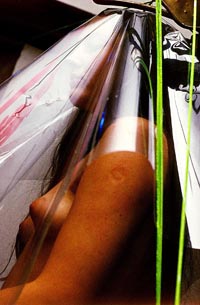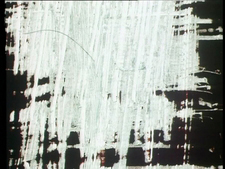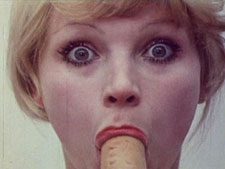10-12 June 2008 SCREENINGS - 7 pm
1,2,3… AVANT-GARDES POLISH FILM/ART BETWEEN EXPERIMENT AND ARCHIVE
Carte blanche given to Lukasz Ronduda and Florian Zeyfang
 Krzysztof Zarebski, Krystyna Jachniewicz, Untitled , 1973 (foto: Leszek Fidusiewicz) Krzysztof Zarebski, Krystyna Jachniewicz, Untitled , 1973 (foto: Leszek Fidusiewicz) Krzysztof Zarebski, Krystyna Jachniewicz, Untitled , 1973 (foto: Leszek Fidusiewicz)1,2,3... Avant-Gardes explores and challenges the 'continuous' history of experimentation in film and art and the interaction between both fields. It also seeks a possible history for Polish avant-garde art and film, to be discovered and reconstructed against many distortions in Polish history over the last 80 years. The project points to different ideas of modernism by examining parallel practices of conceptual film and art production generated from the Cold War era through today. Grounded in the extensive output of experimental film in Poland during the 1970s, 1,2,3... Avant-Gardes offers a selection of films produced primarily by Polish artists from that period, in addition to contemporary work that challenges established histories of experimental cinema. The series will include three programmes: Analytical Strategies, Games and Participation, and Consumption.
Krzysztof Zarebski, Krystyna Jachniewicz, Untitled , 1973 (foto: Leszek Fidusiewicz) Krzysztof Zarebski, Krystyna Jachniewicz, Untitled , 1973 (foto: Leszek Fidusiewicz) Krzysztof Zarebski, Krystyna Jachniewicz, Untitled , 1973 (foto: Leszek Fidusiewicz)1,2,3... Avant-Gardes explores and challenges the 'continuous' history of experimentation in film and art and the interaction between both fields. It also seeks a possible history for Polish avant-garde art and film, to be discovered and reconstructed against many distortions in Polish history over the last 80 years. The project points to different ideas of modernism by examining parallel practices of conceptual film and art production generated from the Cold War era through today. Grounded in the extensive output of experimental film in Poland during the 1970s, 1,2,3... Avant-Gardes offers a selection of films produced primarily by Polish artists from that period, in addition to contemporary work that challenges established histories of experimental cinema. The series will include three programmes: Analytical Strategies, Games and Participation, and Consumption.
TUESDAY 10 JUNE 2008 - 7 PM
"Analytical Strategies"
This programme examines different experimental methods developed during the 1970s by Polish artists linked to collective project such as the Film Form Workshop, and to productions more closely related to educational undertakings, such as films by Józef Robakowski made with his students from the Lódz Cinema School. This material is contrasted with a series of recent works by renowned painter and filmmaker Wilhelm Sasnal. The films share a common interest in deconstructing the film medium and examining cinema's potential for transmitting a new representation of reality. The contemporary works selected, all made using video, seek to re-evaluate the moving image through different analytical, structural and systematic interests.
Józef Robakowski, Test, 1971
 Józef Robakowski, 22x, 1971This non-camera piece was made by puncturing several dozen holes in overexposed motion picture film. When projected, the film 'lets through' the (natural) powerful light of the cinematic projector which 'attacks' the viewer ('recording itself' on his retina).
Józef Robakowski, 22x, 1971This non-camera piece was made by puncturing several dozen holes in overexposed motion picture film. When projected, the film 'lets through' the (natural) powerful light of the cinematic projector which 'attacks' the viewer ('recording itself' on his retina).
Kazimierz Bendkowski, Centre (Centrum), 1973
Bendkowski tests in this film the expressive potential of the cinematic medium. The work is based on an attempt, characteristic for this artist, to balance an incredibly colourful, spectacular visual layer with the faithfulness to a rigorous, rationally constructed structure of the work.
Ryszard Wasko, 30 sound situations (30 sytuacji dzwiekowych), 1975
"30 sound situations" is a performance which maps the acoustic values of numerous divergent ecologies. In each situation, the artist stands before the camera (at various distances) and, with a broad gesture, claps two pieces of wood together.
Pawel Kwiek, 1,2,3.. operator's exercise (1,2,3 cwiczenie operatorskie), 1972
A spontaneous improvisation with a touch of Fluxus flavour, it attempts to „tell a story" about the relation of man to Socialist ideology, more specifically about "having a chapter of the Socialist Youth Association at the ?ód? Film School." Kwiek's film is a mixture of different sorts of formal elements and styles, including animation, acted out scenes and "found" elements (both images and sounds).
Zbigniew Rybczynski, A Square (Kwadrat), 1972
In Rybczynski's "A Square" a simple shape is deconstructed into a series of smaller aimated squares. As color infiltrates these pixels-in-motion, human figures emerge, dancing from one color quadrant to the next. Ultimately the human shapes degenerate, returning to the square from which they emerged. "A Square" cohesively represents Rybczynski's interests in the intersection of dance, film, and music.
Józef Robakowski, 22x, 1971
22x is Robakowski's first assemblage film, made in 1971. It was made in the course of classes the artist taught at the Lódz Film School to students of the Lódz Fine Arts College. Robakowski gave each of the students several metres of unexposed filmstock and asked them to conduct on it whatever material procedures they liked.
Kazimierz Bendkowski, An Area (Obszar), 1973
An Area is a dark and manipulative representation of an urban location and the activities of its inhamitants.
Ryszard Wasko, Straight-curve (Prosta-Krzywa), 1973
Straight-curve is a kind of play between the two-dimensional reality of film and the illusion of three dimensions created by film's representational layer. By contrasting various flat geometrical figures with cinematic recordings of real-world images, Wasko reminds us that film produces only an illusion of three-dimensionality whereas in fact the images are stored on flat film.
Ryszard Wasko, Waclaw Antczak's Trip to the Newsstand on Glówna St. (Podróz Wac?awa Antczaka do kiosku przy ulicy Glównej), 1973
Emphasising the material dimension of the film camera, the artist points to the opposition of the space of the film frame (the representation) and the off-frame space (that which is excluded from the frame, that is the reality continuum).
Wilhelm Sasnal, Kodachrome, 2006
Wilhelm Sasnal, Several Dozen Seconds of a badly Developed Film, 1999/2006
Wilhelm Sasnal, Love Songs, 2005
Sasnal brings the problems dealt with in the minimalist media analyses (a characteristic of, say, the Workshop of the Film Form in the 1970s) into a completely different dimension. The reason behind this is his being aware of the fact that he creates his art in an epoch when production processes have been subjected to an identical fetishization as complete products of such processes. In his films and painting, Sasnal seems to analyze the same phantasmal potential of a 'simple' act of adding a frame (to a film or picture) which divides an imaginary reality from the actuality.
WEDNESDAY 11 JUNE 2008 - 7PM
"Consumption"
Pop Art was a strong tendency in Polish experimental film in addition to the country's better known structuralist cinema practices. The 1970s gave rise to a strong current of artists who considered their own work an attempt to establish a critical or affirmative link with the popular / quasi-consumerist culture of socialist Poland. The group included Natalia LL, Zdzis?aw Sosnowski, Janusz Haka, and Zygmunt Rytka.
Natalia LL, Consumption Art (Sztuka konsumpcyjna), 1972
 Natalia LL, Art de consommation (Sztuka konsumpcyjna), 1972Her work from this period is characterised by the juxtaposition of powerfully 'hot' erotic content with the 'cold' strategies of conceptual art.
Natalia LL, Art de consommation (Sztuka konsumpcyjna), 1972Her work from this period is characterised by the juxtaposition of powerfully 'hot' erotic content with the 'cold' strategies of conceptual art.
Krzysztof Zarebski et Krystyna Jachniewicz, Untitled (bez tytulu), 1973
The film is a documentation of artistic activities, which Jachniewicz and Zarebski carry out in the context of their own apartment (using various objects, filming themselves against pieces of furniture and household appliances), thus blurring the line of division between art and everyday life.
Zdzislaw Sosnowski, Goalkeeper, 1975
This work belongs to a series that Sosnowski started in 1974, highlighting the formation of meaning and the construction of representations in the network of the global communication media, focusing in particular on the way the mass media created contemporary myths to promote idols and their careers.
Zdzislaw Sosnowski et Teresa Tyszkiewicz, Satisfaction, 1979
Sosnowski and Tyszkiewicz criticise the blandness of 1970s Polish television, its utter lack of eroticism and visual appeal, and its excessive subordination to ideology.
Zdzislaw Sosnowski et Teresa Tyszkiewicz, Permanent Position (Stale zajecie), 1978
This erotically charged film by Sosnowski and his wife is a narrative about the intimate relationship shared by two people who love each other. They experiment with attempts to depict their personal relationship, creating bold new representations of their own sexual intimacy in the context of the puritan culture of socialist 1970s Poland.
Zygmunt Rytka, Fiat 126p, 1975
Zygmunt Rytka's works are marked by an affirmative criticality. In this particular film the goal is to analyse the flagship fetish of 1970s Poland's consumer dreams: the Polski Fiat 126p mini-compact car.
Bogdan Dziworski et Zbigniew Rybczynski, Skying Scenes with Franz Klammer (Sceny narciarskie z Franzem Klammerem), 1980
The film, boldly overcoming the codes of the traditional documentary formula, is purely visual (not a single word is spoken) impression of the famous celebrity of the late 1970s.
THURSDAY 12 JUNE 2008 - 7PM
“Games and Participation”
The radical utopian concept of 'Open Form,' developed by the influential Polish architect Oskar Hansen, was originally developed in the international context of late-modernist debates on architecture during the 1950s and was later applied to experiments in cinema and performance by several Polish artists. Hansen employed the concept at the Fine Arts Academy of Warsaw during the 1970s. These sessions witnessed the emergence of the 'artistic game', a mode of practice that encouraged communication and cooperation between the artist and various participants. The films in this programme document some of the artistic games carried out in the period, while two contemporary works recover the element of communication that was typical in Hansen's artistic games. Artists include Oskar Hansen, Pawel Althamer, Artur Zmijewski, Zofia Kulik, Przemyslaw Kwiek.
Przemyslaw Kwiek, Pawel Kwiek, Zofia Kulik et Jan S. Wojciechowski, Open Form, episodes: Playing on the Actress' Face, School (Forma Otwarta, Gra na twarzy aktorki, Szkola), 35 mm, 1971
The sequence Playing on the Actress' Face from the film Open Form is a model example of an 'artistic game' in which each take represents a consecutive 'move' in the game, performed by each artist in a sequence. The players have gathered around a female actor's face and perform various actions. The actress featured in this scene, Ewa Lema?ska, was a popular television star in the early 1970s.
Pawel Althamer, Brodno 2000, video, 2000
Althamers film was produced together wiyh his neighbors in a large residential block in the Brodno district in Warsaw. Althamers interest in social interaction leads to a monumental image, which features the figure 2000 as a code for collective hopes and wishes.
Piotr Andrejew et Zbigniew Rybczynski, Feeling One's Way (Po omacku), 1975
A documentation of games and interactions by Oskar Hansen, Jan S. Wojciechowski, Grzegorz Kowalski, Wiktor Gutt, Waldemar Raniszewski. The film documents a plain air event featuring students and graduates of Oskar Hansen's studio at the Sculpture Faculty of the Warsaw Academy of Fine Arts.
Jan S. Wojciechowski, Oskar Hansen, Grzegorz Kowalski, Waldemar Raniszewski, Wiktor Gutt et d'autres, Game on Morel's Hill (Gra na wzgórzu Morela), 1971
The 'artistic game' method was used here in open space, with the artists dividing into groups and assigning a separate group charged with the task of producing the event's photographic documentation. This film is an excellent example of how this creative method was applied in public spaces.
Artur Zmijewski, Them (Oni), 2007
Them documents a social experiment devised by Zmijewski in which representatives from conflicting social groups (conservatives, patriotic Catholics, nationalist Polish youth, leftist socialists, democrats and freedom fighters) are brought together through a series of workshops. Each group is asked to construct a symbolic centre and then to comment and react to the others. Forcing participants to interact: to negotiate, to fight, or to withdraw.
Zofia Kulik, Przemyslaw Kwiek, Jan S. Wojciechowski, Pawel Kwiek, Krzysztof Zar?bski, Actions (Dzialania), 1972
Aktions was produced in 1972 in a TV studio and was recorded by a professional film crew. The artists invited film-makers, musicians and performers to participate. The freely improvised interactions were supposed to present new forms of open and non-hierarchical communication to a broader audience and improve social relations.
Artur Zmijewski/Pawel Althamer, Choices.pl (Wybory.pl), 2005-2006
Choices.pl is the documentation of an exhibition with the same name that took place in 2006 at CCA Ujazdowski Castle. It was a repetition or restaging of the experimental exercise 'Common Space, Private Space' developed by Grzegorz Kowalski. The participants that Althamer and Zmijewski invited were all former students or teachers at the Warsaw Art Academy and installed the exhibition according to the rules of the nonverbal communication experiment.
PRACTICAL INFORMATION
1,2,3... Avant-Gardes
Polish Film/Art between Experiment and Archive
Carte blanche given to Lukasz Ronduda and Florain Zeyfang
Tuesday 10 June 2008 – 7pm : «Performances»
Wednesday 11 June 2008 – 7pm : «Stories from Another Place»
Thursady 12 June 2008 – 7pm : «Music Lost and Found»
(10-12 June : exhibitions specially closing at 7 pm)
General admission: 10.-
Reduced admission: 6.-
3 showings (3evenings) 20.-/ 12.-
